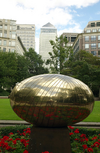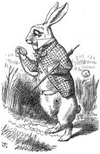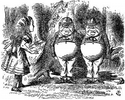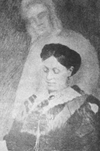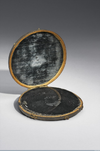Dancing in Wonderland Part 2
The Orphic Circle Meets at the Crystal Palace
One possible meeting place for the Orphic Circle, where they could conduct their ceremonial and practical rituals involving clairvoyants or trance mediums was Craven Cottage in Fulham, North London (what is left of the Cottage still stands today and now forms part of the Premier League Fulham Football Club’s stadium). Bulwer-Lytton owned or rented the property between 1840 and 1846. He held sumptuous parties there where guests included Louis Napoleon (the deposed Emperor of France) and Benjamin Disraeli [Prime Minister of Great Britain]. Robert Browning the famous poet would also spend time recuperating there after an illness. The spiritualist, Samuel Carter Hall, confirmed in his memoirs that séances were definitely held there. He recalled that a young French clairvoyant, Alexis Didier, performed his mesmerism there only days after arriving in England in 1844. Craven Cottage had some odd features that may have made it ideal for such performances. These were a room referred to as ‘the Robbers Cave’, which had a doorway in the ceiling and the door into the library (known as the Egyptian Hall) had ancient Egyptian style pillars on either side. Craven Cottage was in fact a large rural residence and not a small cottage despite the name. Laurence Hutton in his description of the Cottage in his ‘Literary Landmarks of London’ described it as follows: “It stood in 1885, a picturesque ruin, and must have been, in its day a very remarkable specimen of fantastic architecture, embracing the Persian, Gothic, Moorish and Egyptian styles.” This would make it the perfect setting for rituals harking back to earlier times and ancient traditions. Whether Emma Britten performed her trance medium sessions for the Orphic Circle there is not known for certain but there is every likelihood that she may have done so since she was already 17 years old when Bulwer-Lytton first moved into Craven Cottage. One researcher, Mark Demarest (who had access to the Emma Hardinge Britten Archive), has argued that Craven Cottage did serve as the backdrop for the Circle events described in her biography Ghost Land (see more below on this).
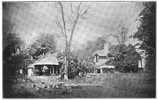
Craven Cottage in the 19th Century
Quoting from the
Georgian Group Journal Volume XIX:
"In 1805 the cottage had been bought by
Walsh Porter, who lived only another four years afterwards but made extensive and expensive changes to the house. With the help of the young architect
Thomas Hopper, he converted the central reception room into an ‘Egyptian Hall’ picking up on the evidence for ancient Egyptian temple decoration which had come to light during the recent Napoleonic invasion of Egypt. The columns, inward-tapering doorways and walls were decorated with mythical beasts, hieroglyphics and lotus leaves. Stranger still, the drawing shows palm trees on delicate trunks, their leaves touching the ceiling. By one door was ‘a movable camel in bronze’ and draping another was a curtain painted as a tiger skin, held up by a life-sized female figure in bronze."

A sketch of the ‘Egyptian Hall’ at Craven Cottage
An Hypotheses on the Orphic Circle
I now turn to an interesting hypothesis put forward by Marc Demarest, which I will quote from liberally since it establishes new connections between the Orphic Circle and other esoteric groups in Victorian England with overlapping memberships that again provides us with examples of circles operating within circles. I have included my own comments in red.
When quite young, in fact, before I became acquainted with certain parties who sought me out and professed a desire to observe the somnambulistic tendencies for which I was then remarkable. I found my new associates to be ladies and gentlemen, mostly persons of noble rank, and during a period of several years, I, and many other young persons, assisted at their sessions in the quality of somnambulists, or mesmeric subjects...it was one of their leading regulations never to permit the existence of the society to be known or the members thereof named, until they passed from earth to the higher life. It is in virtue of this last clause that I am at liberty to say that Lord Lytton, the Earl of Stanhope, and Lieut. Morrison (better known as “Zadkiel”), and the author of “Art Magic,” belonged to this society.
“By One Who Knows,” in “Occultism Defined” from The Two Worlds, 18 November 1887, pp. 3-5.
From the age of twelve my public life commenced; and anyone who has become acquainted with the severe studies which musical artistes are called upon to pursue in Europe… will scoff at the idea that any leisure could have been afforded me for those metaphysical and scientific studies in which certain of my American friends confidently affirm “my youth was absorbed.” With the exception of a little dabbling in astrology, pursued under the auspices of merry gipsying parties, I never heard of, much less studied, any “ology” in my life.
Emma Hardinge, “
To the Reader”, from
Six Lectures on Theology and Nature
Never understood by those around me, it was only in after years and when I became called and associated with a secret society of Occultists and attended their sessions in London as one of their clairvoyant and magnetic subjects, that I myself began to comprehend why a young girl fairly educated, and blessed with many advantages, should be branded with such peculiarities of disposition as must inevitably shut her of from all companionship with children of her own age and standing.
The society of Occultists to whom I can now only allude, and who are named in "Ghost-Land" as the "Orphic Circle," obtained knowledge (by means I am not at liberty to mention) of those persons whose associations they desired.
None of the members were known as such outside their circles, the existence of the society was undreamed of, and those whom they chose to affiliate with they knew of and called. I having been thus favoured obtained a clue to my own exceptional early experiences, which the subsequent developments of Spiritualism stamped as natural Seership.
Emma Hardinge Britten, Autobiography
Issue
Emma Hardinge Britten alleged, in various forums during her lifetime (and in the text that became her posthumous Autobiography), that an English occult group she referred to as the Orphic Circle existed in England in the 1830’s and/or 1840’s, and that she was a member of this group. Did such a group exist? Are Emma’s claims plausible?
Hypotheses
1. The Orphic Circle was a loose-knit community of occult practitioners, with shifting membership and disciplinary focus, that operated in one form or another from the 1820’s until at least the mid-1850’s, primarily in London, but also elsewhere in Great Britain.
2. The name 'Orphic Circle' was never used by the members of the community to describe themselves or their gatherings. The ʻOrphic Circle’ was in no sense a formal organization; it was a social network.
3. The initial incarnation of the Circle was more formal and referred to itself as the Mercurii in public. It formed itself around John Varley the elder 1 (1778-1842), Richard Cross Smith (1795-1832), Richard Morrison (1795-1874), Thomas Oxley (1807-1837) and others, 2 was initially a mutual aid society for practicing astrologers 3 and was as much interested in the exchange and discussion of rare manuscript material on occult topics as it was in practical occultism.
4. Richard Morrison - who was (a) socially mobile (unlike other practicing astrologers of his time) and (b) a polymath, introduced the use of clairvoyants 4, and the practice of skrying, into the Circle’s activities. On the death of Richard Cross Smith, Morrison took control of the Mercuriiʼs activities, and it is through his social connections that people who were not practicing astrologers became members of the Circle.
5. The (a) introduction of members into the
Mercurii Circle who were not practicing, working astrologists, whose interests lay elsewhere within the occult sciences and who were of different social class than the founding members, combined with (b) the death of Varley, Cross, and others moved the Circle’s centre of gravity away from astrology and related divination-oriented practices, and into areas more closely aligned with mesmerism and modern spiritualism, as well as with the broad set of practices grouped under the heading “
Rosicrucian” as that term was understood in Victorian culture.
___________________________________
1 To distinguish him from his grandson, John Varley the younger, also a watercolourist, and an early and serious member of the Theosophical Society.
2 Owen Davies. Witchcraft Magic and Culture 1736-1851. p. 238.
3 Emmaʼs reference to her early experiences with the occult as “
a little dabbling in astrology” may therefore be -- in her typical fashion -- an oblique reference to the Mercurii rather than a throw-away line.
4 See the curator’s blog entry entitled “
A Trout In The Milk” at
Redirecting... 2009_03_01_archive.html for an example of a periodical (a) edited by E.L. Blanchard (b) containing a transcription of a Mercurii session led by Morrison featuring (c) the use of a clairvoyante for
remote viewing.
___________________________________
6. Frederick Hockley (1808-1880) became a member of the Circle, episodically, after going to work for John Denley (?-1840?), the book dealer. Hockley injected much of the “Rosicrucian” and spirit communications thought into the group, though it is clear that R. C. Smith and Francis Barrett (1770?-1830?) were also interested in this sort of material. It seems plain that most of Hockley's practical occult work was done solo, and that he was not by nature a joiner, so his involvement with the Circle during its transition from astrology to occult topics was peripheral.
7. Edward Bulwer Lytton (1803-1873) was brought into the circle by John Varley the elder some time in the 1830s, originally based on Lyttonʼs long association with Varley, and Bulwer- Lyttonʼs interest in geomancy [MJF: a subject the 17th Century Rosicrucians also took a great deal of interest in]. Bulwer-Lytton largely took control of the Circle’s activities after Varley’s death, in partnership with Morrison, and remained involved with the Circle until the mid- to late 1840s, when his social position made it increasingly risky for him to associate with what were perceived to be fringe social elements. He was always careful not to advertise his involvement with the Circle (giving Rosina Bulwer Lytton, for example, nothing to accuse him of on this score).
8. Bulwer Lytton and John Varley bridged the Circle’s network into the social network surrounding Marguerite Countess Blessington* (1789-1849) at Gore House: the so called Gore House Circle. Varley was the Gore House Circle’s resident astrologer, and Bulwer Lytton an intimate friend of the Countess Blessington. Varley and Bulwer Lytton connect Benjamin Disraeli (1804-1881), John Forster (1812-1876), Charles Dickens (1812-1870) and Chauncy Hare Townshend (1798-1868) -- all members of the Gore House Circle -- to the Orphic Circle, at one remove. Dickens, Forster and Townshend were, as is well known, committed believers in mesmeric science.
*Lady Blessington supposedly owned a special rock crystal ball a few inches in diameter, which she sold with other effects in 1849. Apparently, people claimed to see visions in it. Her lover, the French Count D’Orsay. reputedly employed an alchemist to make gold to pay his debts.
9. When Edward Bulwer Lytton was actively directing the Circle’s activities, and in possession of Craven Cottage (c1840-46), meetings of the Circle frequently took place there, and it is Craven Cottage that serves as the backdrop for Circle events described in Ghost Land.
10. Richard Francis Burton (1821-1890) was brought into the circle by John Varley and remained involved with the circle during his brief period at Oxford (1840-42). He remained involved with Orphic Circle figures, particularly Morrison, on his return to England, but was on the periphery of the Circle from 1860 onwards, as his primary interests and social connections lay elsewhere in the esoteric domain (see Richard Monckton Milnes and the Cannibal Club below).
11. Philip Henry Stanhope (1871-1855) was a member of the Circle, through his connections with the Varley family and with Bulwer-Lytton. Stanhope was an unabashed practicing skryer, fond of staging social ʻmorningsʼ in which people -- Elizabeth Barrett Browning, among others -- were introduced to the practice by communing with “the spirits of the sun” as seen in Stanhope’s crystal, and equally fond of ʻoutingʼ prominent figures who were, in private, occult practitioners but who were unwilling to admit such in public. Philip Henry Stanhope, like Hockley, was nomadic, and was of course for some of the period under discussion here in Europe, and thoroughly enmeshed in the Kaspar Hauser scandal*, which is largely what he is remembered for today. Additionally, it seems clear from what information we have about his father Charles Stanhope (1753-1816) that Philip Henry Stanhope’s relationship with the Varleys was one of uneasy intimacy. Samuel Varley (1744-1828) was John Varley the elder’s uncle, and was Charles Stanhope’s partner, for many years, in Stanhope’s various mechanical and chemical pursuits; Samuel Varley was bequeathed [£]1000 pounds and a large body of equipment and instruments in Charles Stanhope’s will; Philip Henry grew up in close proximity to John and Cornelius Varley (1781-1873) on Charles Stanhope’s estate; it may be that John Varley the elder’s father, Richard (?-?), was Philip Henry’s tutor for a time; Philip Henry Stanhope saw the Varleys generally, and Samuel Varley specifically, as a significant financial drain on his inheritance, grumbling at the time his father’s will was proved that he would have been in much better shape, financially, had Samuel Varley not pandered to his father’s weakness for experimentation and invention.
*See postscript for The Enigma of Kaspar Hauser
12.
Edward Lyman Blanchard (1820-1889), the literary jobber, editor and chronicler, was involved with both the Mercurii (as the editor of various astrological magazines in the 1840s) and the Orphic Circle.
5
13.
Sir Charles Wyke 6 (1815-1897) the
British diplomat was involved, from time to time, in the activities of the Circle, having been brought into the Circle by Edward Bulwer Lytton, whom he knew in political life. Wyke was outspoken, in his later years, about his involvement with the Circle, and has left us (through third parties) descriptions of what may be the Circle’s practices, in summary fashion at least.
7
_________________________________
5 E. L. Blanchard was not the only nomadic figure crossing between dramatic and occult circles in this period.
Hargrave Jennings, who is cited as a (plagiarized) source of Emmaʼs materials by Olcott and others, was the backstage manager of the Covent Garden theatre for many years. He and Blanchard knew one another.
[MJF: John Hargrave Jennings was a Freemason, a friend of Charles Dickens and an historian of the occult. He wrote The Rosicrucians without Change.]
6 Charles Lennox Wyke is a pivotal connective figure in this network, particularly at the open boundary between occult practice and public diplomacy. He knew the Barings [MJF: A major banking and establishment family of the 19th and 20th Centuries], Monckton Milnes, Bulwer Lytton, Disraeli, Stanhope and other figures well, as far as I have been able to determine. Aside from his career as a diplomat, little has been written about him and I have been unable to locate his papers. Wyke was, however, in and around London during two periods of a career otherwise spent largely out of the country: 1838-1845, and 1860-1866. Additionally, Wyke is on record as claiming that he was present, with Bulwer Lytton, when
Eliphas Levi performed the
Ritual of Conjuration to raise Apollonius of Tyana on the roof of the Pantheon department store in London in 1854. This event and Leviʼs time in London more generally are of interest, as we have it on
A.E. Waiteʼs authority that Levi was a member of a London based occult circle during this period, was expelled from that circle for revealing its secrets (see, for example, Richard Cavendishʼs
The Black Arts, p. 29.), and was initially lured into performing the Rite of Conjuration by an unnamed female “adept” of Bulwer Lytton’s circle. Who might she be?
Quoting from Levi’s Wikipedia entry:
Of his initial experience with British esotericists, in 1854, Levi wrote: "I had undertaken a journey to London, that I might escape from internal disquietude and devote myself, without interruption, to science. [...] They asked me forthwith to work wonders, as if I were a charlatan, and I was somewhat discouraged, for, to speak frankly, far from being inclined to initiate others into the mysteries of Ceremonial Magic, I had shrunk all along from its illusions and weariness. Moreover, such ceremonies necessitated an equipment which would be expensive and hard to collect. I buried myself therefore in the study of the transcendent Kabalah, and troubled no further about English adepts."
It did not take long after his arrival in England, however, before his skills as a reputed magus were earnestly courted; and Levi obliged: An elderly British woman, who, on the agreement to strictest secrecy, "rigorous amongst adepts," provided him with "a complete magical cabinet" containing the necessary paraphernalia to apply his theories to the practice of magic in England.
[Levi] had a deep impact on the magic of the Hermetic Order of the Golden Dawn and later on ex–Golden Dawn member Aleister Crowley.
7 Wykeʼs willingness to discuss his involvement in the Circle, and to subject his subordinates in the diplomatic corps to demonstrations of skyring and other practices makes me hopeful that Wykeʼs papers, if they can be found intact, will contain important material on the Circle, its membership and its practices.
_________________________________
14. Sir Charles Wyke brought both the Rev. Henry George de Bunsen (1818-1885) and Ernest de Bunsen (1819-1903) into the activities of the Circle, no earlier than mid-1841 (when Ernest de Bunsen was in London on German ecclesiastical business), and more probably in 1842 (when Ernest de Bunsen and Henry George de Bunsen became permanent residents). The de Bunsens were already involved in occult-related studies 8, through their father Christian (1791-1860), scholar, tutor to the family of John Jacob Astor [MJF: The Astors are a prominent Illuminati family with strong ties to the Rothschilds], and diplomat, who was also deeply interested in biblical studies and Egyptology. Henry George was only peripherally involved in occult practices, but Ernest was more deeply involved, and more committed, to occult studies.
15.Ernest de Bunsen 9 and Henry George de Bunsen formed the linkage between the Orphic Circle and the Berlin Brotherhood, directly (both travelled extensively between Great Britain and Germany) and via their brothers who remained in Germany (including in Berlin) and travelled frequently to London. The name “the Berlin Brotherhood” was a pun, as in fact the members (in the real sense) were brothers. [MJF: Hence, we finally find an explanation for “the Berlin Brotherhood”, which Emma Hardinge Britten had spoken of in Ghostlight]
16.Richard Monckton Milnes (1809-1885) was aware of the existence of the Circle, through his close relationships with the de Bunsens, with Burton, and with Bulwer-Lytton, but was not himself a member. Milnes is an important gateway node to other outre social networks of the period, in particular the Cannibal Club circle [MJF: see more on this below], in which later public Masonic and Rosicrucian figures would claim membership.
17. Emma Hardinge Britten (as Emma Floyd) was brought into the Circle as a clairvoyante subject (that is, as a research tool) (a) by Edward Bulwer-Lytton or by John Varley the Elder, (b) by Chauncy Hare Townshend, or (c) by R.J. Morrison. Her introduction occurred in the 1838-1841 period, as Emmaʼs articles to Thomas Welsh expired, and Emma began to transition her career from musical performance to stage acting.
_______________________________
8 The von Bunsen clan were also socially intimate with F. D. Maurice (1805-1872), usually pointed to as a [sic] if not the father of Christian Socialism. This open boundary between a crypto-Spiritualist family and the religious and political reform movements of the mid-Victorian period deserves exploration, considering (a) the Owenite influences on both sides of the boundary, as well as (b) the interesting phenomenon of Chartist conversions to Spiritualism, and (c) the plain fact that most of the founders of the Society for Psychical Research were either members of the Apostles at Cambridge, or tutored by Apostles.
9 The de Bunsen (rather than the original von Bunsen) surname is in Ernest and Henry Georgeʼs cases a voluntary adoption, an “Anglicisation” of von Bunsen. Other family members remained von Bunsens.
__________________________________
18. If it was Bulwer-Lytton or John Varley the elder who bright Emma into the Circle, that person who met her in the Blessington Circle at Gore House, where her clairvoyance was put on display, or where her clairvoyance was disclosed while she was performing, as a pianist, for the Gore House Circle.
19. If it was Chauncy Hare Townshend who brought Emma into the Circle, he did so after discovering her clairvoyante per se, directly, through Charles Dickens, or through Townshend’s close friend and executor, Thomas Helmore. Emmaʼs clairvoyance was apparently well-known in musical circles, and Thomas Helmore 10 would have known of Emmaʼs clairvoyance through his friendship with Thomas Welsh, Emmaʼs employer.
20. If it was Morrison who brought Emma into the Circle, how he met her is as yet unknown, but it is possible that Morrison met Emma through E. L. Blanchard, who would have known Emma through Emmaʼs magazine work 11 (under the pseudonym Ernest Reinhold).
21. Emma formed several relationships as a result of her membership in the Circle: (a) she was for a period of time a familiar, and perhaps a mistress, of Edward Bulwer Lytton, who may have been the original of the “member of Parliament” for whom Emma claimed to act as “amanuensis” 12 in matters involving “state secrets” ; (b) she was a correspondent of, and possibly for a period of time a mistress of, Charles Dickens, who may be the original of the “baffled sensualist” Emma discusses in her autobiography; (c) she formed a lasting relationship with Ernest de Bunsen, who provided her with material for Art Magic and Ghost Land (at least Volume I).
22. Ernest de Bunsen used Emma to publish his more outre occult research while he -- publicly, and with decidedly minimal success -- attempted to build his career in England as an (unorthodox) scholar of contemporary religion, comparative philology and Oriental studies. He published through Emma largely to protect his public career and persona, which were controversial enough -- his occult research would have buried him as a public intellectual.
_______________________________
10 Both were members of the Chapel Royal, which Helmore directed for many years.
11 We believe (but have not substantiated) that Emma wrote for several periodicals, including the Court Gazette, as Ernest Reinhold, in the late 1830s and early 1840s, on dramatic and musical topics. It also appears that E. L. Blanchard published material in the Court Gazette, and -- in any case -- the jobbing journalistic circles of 1840’s London were sufficiently small that it seems highly probable that Blanchard and Emma knew one another.
12. The original of this veiled claim, if it has a basis in fact, could as easily have been Benjamin Disraeli, or for that matter Sir Charles Wyke (if we discard the “member of Parliament” attribute and focus on the “state secrets” assertion) who was a vice-counsel in the English diplomatic corps in 1845, and remained in diplomatic service for the rest of his working life. Wyke was a pronounced Germanophile with connections to the House of Hanover who was known to his intimates from the 1830s onward as “the Baron”.
___________________________________
23. Emma published de Bunsen to make money (as she thought). She adopted and extended de Bunsenʼs critique of Christianity because it suited her purpose: to establish Modern Spiritualism as a ‘scientific’ religion to replace Protestant Christianity. Louis de B-----, originally a pseudonym for Ernest de Bunsen, became, later in Emmaʼs life, a convenient attribution for her own opinions and positions in situations where she could not legitimately act simultaneously as editor and correspondent.
24.Art Magic is largely the work of Ernest de Bunsen.
25.Ghost Land, Volumes I and II, are largely the work of Emma Hardinge Britten, informed by the work of Ernest de Bunsen, by her experiences as a peripheral member of the Orphic Circle, and by her imagination. This is particularly the case with Ghost Land, Volume II, which should be seen as an example of the latter portion of hypothesis #23.
Commentary
This is a remarkable piece of research in that it exposes a whole plethora of networks involving prominent statesmen, aristocrats, diplomats, writers, artists and other notables who all seem to have been involved in occult or spiritualist practices of one kind or another during the 19th Century, including alchemy. This last arcane, occult art may provide us with a link to the original 17th Century Rosicrucians, many of whom were alchemical practitioners such as John Dee, Sir Francis Bacon, and Thomas Vaughan. Hence, we may be seeing here the preservation of a Rosicrucian tradition that takes us well into the 19th Century. You will notice, however, that nowhere in the above hypothesis is any mention made of Lewis Carroll. In order to find a connection between Carroll and these networks, we need to look more closely at some of the individuals and groups mentioned in Demarest’s hypothesis. I shall start first with the Mercurii Circle, as they seem to have been the forerunners of the Orphic Circle.
The Mercurii Circle
The Society of the Mecurii was an occult magical organisation that operated in London, in the 1830s and was one of the primary groups that launched the occult and astrological revival that has led to the spectacular growth of the occult world in the twentieth century. The first public mention of the society seems to have been an announcement in the 14 August 1824, issue of
The Struggling Astrologer, a magazine that had been launched by astrologer
Robert Cross Smith (1795-1832), later to become famous under his pen name
Raphael. According to the brief statement, the society consisted of some "scientific gentlemen" interested in promoting occult science. In a later issue it was noted that the number of the society were few and select and that their meeting place was secret. It was noted, however, that they wished to publish occult books, and could be contacted through Smith.
Beyond Smith, the exact membership of the society is unknown, but some speculation can be made from knowledge of those who were associated with him. One possible early member was artist
Richard Cosway (d. 1821). Above and beyond his art, he gathered a large occult library, lectured on occult topics, and
practiced spirit contact via clairvoyance. When he died, Smith came into possession of his library.
The Struggling Astrologer was succeeded by a new periodical in 1825,
Urania; or, The Astrologer's Chronicle, and Mystic Magazine, which listed Smith as the editor under the pseudonym "Mecurius Angelicus, Jur." assisted by members of the Mercurii. Like
The Struggling Astrologer, Urania lasted only a few issues. However, after it folded Smith published a collection of articles from the two periodicals as a book,
The Astrologer of the Nineteenth Century, described as a compendium of occult materials by members of the Society of the Mercurii.
From the Smith publications, membership of the Mercurii appears to have included:
George W. Graham, an
alchemist who assisted Smith in setting up his business;
John Varley (1778-1842), a noted artist and friend of the artist/poet
William Blake and student of astrology; and
John Palmer (1807-1837), a young alchemist who wrote for Smith.
During this period of time, the only other significant occult group in England was the circle that had formed around magician
Francis Barrett, author of
The Magus, a seminal text of magical wisdom that stands at the fountainhead of modern magical practice. The Mercurii apparently dissolved following the death of so many of its members in the 1830s, though given its secretive nature it could easily have survived much longer. [
MJF: Given the involvement of Richard (Robert?) Cross Smith and John Varley, one may assume it survived by morphing into the Orphic Circle – see Mark Demarest’s hypothesis 3 above.]
The Cannibal Club was a Victorian dining club associated with The Anthropological Society of London, most likely founded at the same time in 1863 by Sir Richard Francis Burton and Dr James Hunt. The club met in Bartolini's dining rooms near Fleet Street, London. Its official symbol was a mace carved to look like an African head gnawing on a human thighbone. The club's name is thought to derive from Burton's interest in cannibalism which he regretted that he never witnessed on his travels. Club members included: Richard Monkton Miles, Charles Bradlaugh, Thomas Bendyshe, Algernon Swinburne, Sir James Plaisted Wilde, General Studholme John Hodgson and Charles Duncan Cameron.
As we learned above, Sir Richard Burton was also a member of the Orphic Circle. Although Richard Monckton Milnes was not a member of the Orphic Circle, he had close contacts with Lord Bulwer-Lytton and the de Bunsens who were leading members. As mentioned above, many of the members of the Cannibal Club were also prominent Freemasons and Rosicrucians. Hence, we see again overlapping circles within a wider esoteric network or web.
In his biography of Sir Richard Burton, the writer Dane Kennedy suggests that "the very name of the new club signalled the determination of its organisers to create an atmosphere where subjects deemed deviant by society could receive an open airing" and to liberate its participants from "the sober, 'scientific' etiquette that governed the proceedings of the Anthropological Society."
Burton's brother-in-law and father-in-law attended the club's meetings which he facetiously referred to as "orgies." Kennedy argues that the club's function has been widely misunderstood. The Cannibal Catechism – written by Swinburne for the club – as well as the club's membership, suggest that the dinners served as an opportunity for renowned radicals and social misfits to air their views: "The Cannibal Club was much more than a meeting place for homosocial merriment; it was in fact a venue for venting what were considered at the time subversive opinions about religion, race, sex, and much more."
Here is one description of the Club’s activities:
“On Tuesday nights, in Bertolini's backroom, respected judges and doctors, esteemed lawyers, admired politicians and award-winning poets and writers drank heavily, smoked cigars and secretly discussed what they thought they knew of the British colonies, more specifically polygamy, bestiality, phallic worship, female circumcision, ritual murder, savage fetishes and island cannibalism. The gentlemen would trade in exotic pornography and tales of flogging and prostitution.”
However, the roots of the Cannibal Club lay in the debate between monogenism and polygenism.
Monogenists believed that all of humanity shared a common ancestry while
Polygenists were convinced that different races of man had different origins [MJF: Something the later Theosophists promoted and, of course, the C’s have averred as being true]. Thus, there was a tension in Victorian England between the creation of a democratic scientific methodology and the elitist attitudes that reinforced Anglo-Saxon superiority. By 1863, this tension drove a wedge between the Polygenist and Monogenist members of the then 20-year-old
Ethnological Society of London. Determined to continue advocating their polygenist ideologies, Captain (Sir) Richard Francis Burton and Dr. James Hunt, both members of the Ethnological Society of London, broke away and established
The Anthropological Society of London.
From the intellectual ferment of the Anthropological Society's inaugural year grew an even more exclusive and overtly seditious conclave of high-society rebels: a gentlemen's dining group called the Cannibal Club. Though Hunt was the president of the Anthropological Society, Burton, who possessed a Byronic love for shocking people, was to be the mastermind behind the new hush-hush fraternity.
Richard Francis Burton was an experienced geographer and explorer, a writer and translator who spoke 29 languages, a decorated captain in the army of the East India Company and a renowned cartographer. Burton was also considered by some to be a rogue, a murderer, an impostor and betrayer, a sexual deviant, and an heroic boozer and brawler. He was six feet tall (at a time when most Victorian men were little more than five feet six inches tall) with a barrel chest and an imposing scar on his left cheek. He was famous for infiltrating Mecca in 1853, disguised as an Arab merchant and for translating the raw, unexpurgated texts of erotic Eastern literature such as the
Kama Sutra and the
Arabian Nights. He was presented to Queen Victoria, and he dined with the Prime Minister. When asked by a young vicar if he'd ever killed a man, Burton replied cooly, "
Sir, I'm proud to say that I have committed every sin in the Decalogue." Burton was one of Hell's original hounds and the Cannibal Club was his sanctuary.
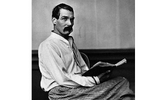
Sir Richard Francis Burton
Swineburne, a short and fragile man with a little weasel-like mouth, was perhaps one of the clubs most debauched members. As a suicidal algolagniac, alcoholic and habitué of London's flagellant brothels, Swineburne also contributed to the eminent 11th Edition of the Encyclopaedia Britannica and was nominated for the Nobel Prize in Literature every year from 1903 to 1907 and again in 1909. After Swineburne's Catechism was recited, the members would "
eat, drink, and let their conversations veer absolutely wherever they wanted", writes Monte Reel in
Between Man and Beast. "
The members were drawn to one another thanks to a shared hatred for one 'Mrs. Grundy'—a fictional composite who epitomized the tight-laced prudery that threatened to define the era." Mrs. Grundy eventually manifested herself in the Society for the Suppression of Vice and various British obscenity laws [
MJF: Mrs. Grundy thus represented the Victorian equivalent of the real-life, late 20th Century British morality campaigner Mary Whitehouse. See: Mary Whitehouse - Wikipedia] Needless to say, no minutes were kept during the meetings.
Cannibal Club members were culture-warriors. They were generally sympathetic to all religions yet loyal to none. They were unapologetic hedonists and scientific racists. They exhibited an unbridled interest in the various expressions of human sexuality and saw sexual repression as a national crisis. Another central figure of the club was
Charles Bradlaugh, a political activist, renowned atheist and the founder of the
National Secular Society. Bradlaugh was a pamphleteer who openly published information on land reform and birth control. In 1880, when Bradlaugh was elected to Parliament, he refused to take the religious oath—an act for which he was briefly imprisoned in a cell beneath Big Ben. In 1891, his funeral was attended by 3,000 people including a then 21-year-old
Mohandas Gandhi.
Another cornerstone of the club was
Baron Monckton Milnes, a poet, patron of literature and politician. Milnes' unrivalled private collection of pornography, which was known to few during his lifetime, now sits in the British Library. English author, Jean Overton, contends that Milnes was the author of
The Rodiad, an unattributed pornographic poem published in 1871 about a schoolmaster who derives pleasure from flogging young boys. Cannibal Club members truly lived dual lives: honourable gentlemen by day, perverse pleasure-seekers by night
[MJF: such hypocritical characters being reflected perhaps in Scottish author Robert Louis Stevenson’s gothic horror story The Strange Case of Dr Jekyll and Mr Hyde - which in popular culture would coin the phrase "Jekyll and Hyde", a phrase used in the vernacular to refer to people with an outwardly good but sometimes shockingly evil hidden nature].
But the Cannibal Club, as a furtive extension of The Anthropological Society, had motivations beyond simply rabble-rousing. In
Reading Arabia: British Orientalism in the Age of Mass Publication, 1880-1930, author Andrew C. Long writes:
In the latter half of the 19th century the erotic viewing privileges of the club and its consumers were undermined as British and French companies began to mass-produce pornographic postcards, many of them exploiting colonial imagery much like the Cannibal Club had been doing all along.
The Cannibal Club lasted just a few short years, however. After Hunt's death in 1869 and Burton's international diplomatic services took him abroad, the old gang began to thin out. By the early 1870s, Darwin's
On the Origin of Species (1859), was selling at a rate of 250 copies per month in Britain and his follow-up,
The Descent of Man, and Selection in Relation to Sex (1871), which focused more on sexual selection and evolutionary ethics, had just hit shelves. Subsequently, the racially motivated polygenist ideology adhered to by The Anthropological Society and, by extension, The Cannibal Club, became passé. In his paper, "
The Cannibal Club and the Origins of 19th Century Racism and Pornography" (2002), John Wallen asserts that Burton tried to revive the Cannibal Club sometime in the 1870s without success.
In 1871, the Anthropological Society and the Ethnological Society of London reunited to form The Royal Anthropological Institute of Great Britain and Ireland, which is active to this day, promoting the public understanding of anthropology.
In many ways, one can see some parallels with the earlier Hellfire Club, whose members were also renowned for their debauched behaviour. Today we might view the members of the Cannibal Club as akin to 20th Century “shock jocks” – broadcasters who express opinions in a deliberately offensive or provocative way – except The Cannibal Club were doing it in private.
For more on the Cannibal Club, see
Jeff M. Campagna’s 2014 article:
The Cannibal Club: Racism and Rabble-Rousing in Victorian England @ The Cannibal Club: Racism and Rabble-Rousing in Victorian England | History| Smithsonian Magazine
However, it is through the Cannibal Club founder Dr James Hunt that we at last find our connection to Lewis Carroll.
James Hunt (1833 – 1869) was an anthropologist and speech therapist in London during the middle of the 19th Century. His clients included
Charles Kingsley (1819-1875) who was the author of
The Water-Babies, Leo Tennyson (son of the poet laureate
Alfred Lord Tennyson), and Lewis Carroll (Charles Lutwidge Dodgson), the author of
Alice's Adventures in Wonderland and
Through the Looking Glass.
James Hunt was born in Swanage, Dorset, the son of the speech therapist Thomas Hunt (1802–1851) and his wife Mary. He was trained by his father in the art of
curing stuttering by means of breath exercises, muscle control and building the patient's confidence. He bought a doctorate from the University of Giessen in Germany and set up a practice in 1856 in Regent Street, London. He dedicated his first
Manual on the subject to Charles Kingsley who spent three weeks with him in 1859. He moved to Hastings where he ran residential courses during the summer season with his sister Elizabeth's husband, Rev. Henry F. Rivers.
In 1854 Hunt joined the Ethnological Society of London because of his interest in racial differences and from 1859 to 1862 was the honorary secretary. However, many members of this society disliked his attacks on humanitarian and missionary societies and the anti-slavery movement. So, in 1863 with the help of the explorer Richard Burton he set up, as we saw, the Anthropological Society of London, becoming its first president.
He established the
Anthropological Review as the organ of the Society and by 1867 the membership of the Society had reached 500. However, by 1867 allegations by one of the members
Hyde Clarke of financial irregularities in his running of the society caused his temporary resignation as president, though he returned in 1868 when Clarke was expelled. This took a toll on his health and in 1869 he died of an inflammation of the brain. The society shortly afterwards started discussions to merge with the Ethnological Society.
Lewis Carroll came to Hunt because he had a stammer that was said to have affected his job. The 1861 census shows that Charles Lutwidge Dodgson was staying at Ore House in 1861 and being treated by Dr. Hunt a psellismollogist. Since Carroll’s book
Alice’s Adventures in Wonderland was published in 1865, it is quite possible that some of it was written during his stay with Hunt.
The question we need to ask is did Lewis Carroll turn to Hunt for help through his connections with Orphic Circle members, possibly his fellow novelist Charles Dickens or through Hunt’s Anthropological Society co-founder Sir Richard Burton (N.B. By 1861 though Burton was on the periphery of the Circle)? Could Lewis Carroll himself have been a member or associate of the Orphic Circle? And what of Carroll’s fellow novelist, Charles Kingsley?
Charles Kingsley, an Anglican clergyman, and novelist was a fervent Anglo-Saxonist and was seen as a major proponent of the ideology, particularly in the 1840s. He proposed that the English people were "
essentially a Teutonic race, blood-kin to the Germans, Dutch, Scandinavians". Kingsley suggested there was a "
strong Norse element in Teutonism and Anglo-Saxonism". Curiously, he believed that the ancestors of the Anglo-Saxons, Norse and Germanic peoples had physically fought beside the god
Odin, and that the British monarchy was genetically descended from the god [
MJF: “Odin’s children” – which may reflect belief in the existence of a special Nordic (hybrid) bloodline]. One wonders whether he may have obtained these ideas through people like James Hunt and the Cannibal Club and/or the Orphic Circle.
In 1859, Kingsley was appointed chaplain to Queen Victoria and in 1861 he became a private tutor to the Prince of Wales (later King Edward VII). In 1860, he also became
Regius Professor of Modern History at the University of Cambridge. Thus, we can see that he was very much an establishment man. Since they moved in similar circles and were mutual clients of Hunt, it is possible that Lewis Carroll knew his fellow novelist and academic Charles Kingsley. However, there is nothing to suggest that Kingsley was a member of the Orphic Circle or the Cannibal Club (highly unlikely given his standing as a senior Anglican clergyman).
However, it is clear that Kingsley knew Orphic Circle member, fellow novelist and social activist
Charles Dickens as he sat on the 1866
Edward Eyre Defence Committee along with Dickens, Thomas Carlyle, John Ruskin, John Tyndall, and Alfred Lord Tennyson (
MJF: whose son was, like Kingsley, a client of Hunt’s), where he supported Jamaican Governor Edward Eyre’s brutal suppression of the Morant Bay Rebellion against the Jamaica Committee.
It is noticeable from the above and throughout this article that many famous British writers, authors, novelists, and artists of the Victorian age were connected to social reform movements and to various political causes. Some of them like Carroll and Dickens seem to have been linked to the Orphic Circle, which numbered powerful statesman and aristocrats amongst its ranks. However, there is another far less well known Victorian secret society, which also had an eclectic membership, one which may provide the ultimate link to Lewis Carroll and Alice’s surreal experiences in Through the Looking Glass and one which had deep roots in the 17th Century Rosicrucian movement.
To be continued





